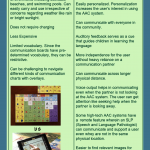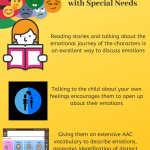Supporting Special Needs Children During a School Crisis
Parents send their children to school so that they can learn and develop skills that will enable them to lead a purposeful life. They meticulously evaluate the education policy and the curriculum of the school before enrollment. However, very few parents check if the schools have emergency preparedness programs that support special needs children.
Schools do their best to consider the needs of all children in their safety plans, but there is no doubt that more needs to be done. Teachers have expressed concerns about how the system is woefully underprepared for practice lockdowns and evacuation drills, especially when it comes to children with special needs. It is alarming to think about how children would stay safe during a real emergency. Fortunately, there are some steps that can be taken to ensure better preparedness for all children.
Child Assessment
Teachers must make sure that they assess each student to formulate a plan that serves their individual needs. A chart can be prepared for each student, listing attributes that can help or hinder their safety. This will help in coming up with a plan that best suits the student’s abilities.
For children who use AAC apps for communication, the safety plan can be explained through the app they use. Teachers can customize the app to familiarize children with safety routines. This will ensure they know what to do during an emergency.
The school can distribute copies of the finalised individual plan to teachers, parents, and counsellors to keep them informed of the safety procedure to be followed. It is also important to update the plan constantly to keep up with the changing requirements of children with special needs.
Awareness of Parents
Most parents assume that their school district has a strategy outlined to help children with disabilities during a school crisis. However, in the absence of a well-defined nationwide plan, teachers are often left to their own devices.
Parents need to talk to the schools about the drill schedules and lockdown procedures. Discussing the child’s individual needs and how they can be addressed is crucial. Once a plan has been devised, parents can talk to their children about the routines they need to follow. Reminding the kids often will enable them to follow instructions and get themselves to safety.
Navigating the Physical Environment
The school should identify shelters or hiding spots which are conducive for children with disabilities. These shelters should be able to accommodate any assistive technology or device they use, including wheelchairs and crutches. Teachers can encourage children to get to the hiding spots during practice drills by rewarding them with stickers or toys. This will ensure the compliance of the children during a crisis.
In case of natural disasters, or danger from within the building, blocked hallways can pose a problem. Therefore, it is important to be aware of alternate routes to safety. Teachers and other staff must also train themselves to move furniture out of the way as these could block the path(s) to assigned shelters.
Building an Emergency Kit for Special Needs Children
Children with special needs may experience a sensory overload due to loud noise from fire alarms and shouting during lockdowns or evacuation. Having an individual emergency kit for each student helps in such cases and should be a compulsory part of the safety plan. Here are some suggestions for what such a kit for children with special needs could contain
Medication
The emergency tool bag must contain nebulizers or masks for children with respiratory illnesses, medicines for children with diabetes, and medication for children prone to allergies and epilepsy.
Stress Busters
The emergency kit must include a toy or a book that can comfort the child and keep them engaged during the lockdown. Music players with headphones can reduce anxiety in children with special needs. For kids with sensory needs, including sensory toys such as chewelry (chewable medical grade jewellery) and stress balls can help them control their vocalizations.
Communication and AAC Apps
For kids who use iPads or other AAC devices for communication, having such devices in the bag can help them communicate to first responders if needed.

Food and Activities
Packing the favourite snacks and treats of the children along with colouring books and crayons can keep them occupied and calm during the lockdown.
School officials should collaborate with special educators, teachers, and parents to make sure that children with special needs are adequately supported in their emergency plans. The plans should focus on the individual physical, mental, and cognitive abilities of the children. Practicing the drills with the children as specified in the plans is essential to enable them to stay safe during a school crisis.
If you have any experiences to share about the emergency preparedness plans of your kids’ schools, please write about them in the comment section below. Sharing ideas and suggestions can help the community learn and be more aware of the challenges special needs children face regularly.
Subscribe to the Avaz Newsletter
Join 4000+ fellow readers! Get latest articles straight to your inbox. Enter your email address below:
Popular Articles
- Building Literacy: Teaching Grammar to AAC Users
- Expansion of Language: Supporting AAC Learner’s Progress
- Avaz User Stories and Videos
- Avaz Joyful Reading: Resources for Shared Reading
- AAC Resources: Games, Activities and Communication Opportunities
- Avaz AAC User Stories: Why Nishant and his AAC System are Inseparable
- Downloadable Low Tech Communication Boards
- Get the Better of Reading Difficulties with MDA Avaz Reader
- AAC Apps for Adults with Acquired Communication Disorders
- Teletherapy: A smart way to facilitate remote speech therapy for adults and children

